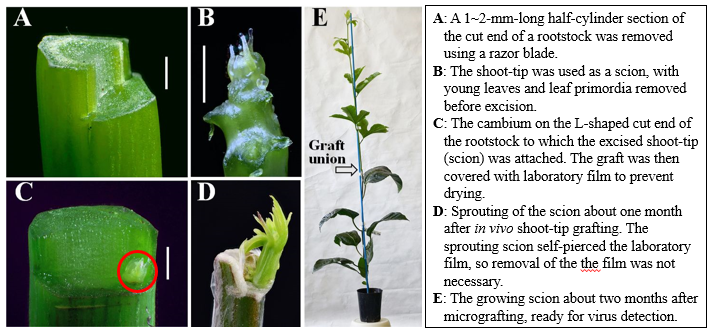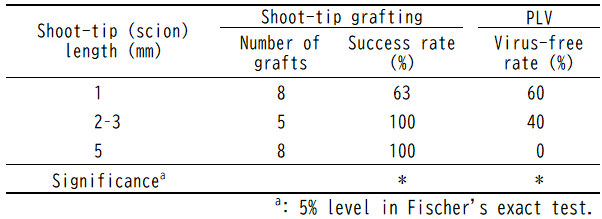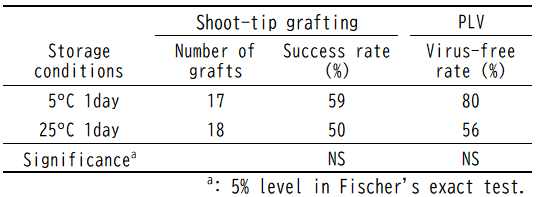Scalable Research Achievement
Development of a simple shoot-tip grafting method for virus-free passion fruit
Description
Passion fruit (Passiflora edulis) is the third most important tropical fruit produced in Japan after pineapple and mango. The plant consists of a woody vine that grows rapidly under warm humid conditions, while fruits can be harvested about five months after planting. Commercial cultivation of passion fruit is therefore possible before winter, even in temperate regions where survival is not possible during the cold months. As a result, cultivation of passion fruit is gaining increasing attention in Japan as one of several alternative crops to replace those increasingly suffering from heat stress under climate change.Management of virus diseases is one of the most important subjects in commercial production of passion fruit. The basic treatment for virus disease control is to introduce virus-free seedlings. However, depending on the type of virus, it is often difficult to detect the external symptoms of the disease such as those caused by the Passiflora latent virus (PLV), thus making the procurement of virus-free plants challenging. In such cases, infected plants must be made virus-free and used as mother trees for propagation. To address the above problem, a technology for virus-free propagation of passion fruit using a simple shoot-tip grafting method has been developed (Fig. 1).
The shoot-tip was in vivo grafted and examined to obtain PLV-free passion fruit from infected plants. The scion length required to eliminate PLV was ≤ 2 mm (Table 1). The method required no aseptic handling and the procedure was relatively simple, and resulted in more than ten grafts in one hour, allowing it to be conducted at an individual farm level. Rapid growth of the scion after grafting was also observed due to the use of fully established seedlings as rootstock. Leaf samples for analysis of PLV infection could therefore be obtained about two months after grafting with fruit harvest possible about four months later (Fig. 1).
In vivo shoot-tip grafting was conducted with a scion length of 0.5–1 mm from September to November to determine the optimal air temperature conditions. The graft success rate increased from 18% to 58% with a decrease in the average air temperature from September (28.6°C) to November (23.3°C), although there was no significant difference in PLV-free rates between months (73% to 80%) (Table 2). Accordingly, in vivo shoot-tip grafting of passion fruit is not recommended under high air temperature conditions.
The effect of scion shoot storage conditions was also examined, revealing that in vivo shoot-tip grafting using shoots stored for one day could be performed without difficulty, whereas the rate of graft success and PLV-free rate were close to those obtained using shoots selected less than 30 min before (Table 3). These findings suggest that with this method, virus-free plants can be obtained using PLV-infected shoots selected in the field one day earlier. In conclusion, our in vivo shoot-tip grafting technique is useful for eliminating PLV from infected plants without any aseptic treatment or specific equipment, and could therefore contribute as a practical method to control virus diseases in passion fruit.
Figure, table
-
Fig. 1. In vivo shoot-tip grafting of passion fruit
Bars in A, B, and C: 1 mm. -
Table 1. Effect of shoot-tip (scion) length on the elimination of Passiflora latent virus (PLV) via in vivo shoot-tip grafting
-
Table 2. Effect of grafting time on grafting success and elimination of Passiflora latent virus (PLV) via in vivo shoot-tip grafting
-
Table 3. Effect of scion shoot storage conditions on the elimination of Passiflora latent virus (PLV) via in vivo shoot-tip grafting
Figure and tables reprinted/modified with permission from Ogata and Yamanaka (2021) .
- Classification
-
Technical
- Research project
- Program name
- Term of research
-
FY 2017–2022
- Responsible researcher
-
Yamanaka Shinsuke ( Tropical Agriculture Research Front )
MIERUKA ID: 001785Ogata Tatsushi ( Tropical Agriculture Research Front )
MIERUKA ID: 001788 - ほか
- Publication, etc.
-
Ogata and Yamanaka (2021) Horticulture Journal 90: 280–285https://doi.org/10.2503/hortj.UTD-259
- Japanese PDF
-
2021_C02_ja.pdf416.6 KB
- English PDF
-
2021_C02_en.pdf1.26 MB
- Poster PDF
-
2021_C02_poster.pdf1.37 MB
* Affiliation at the time of implementation of the study.




